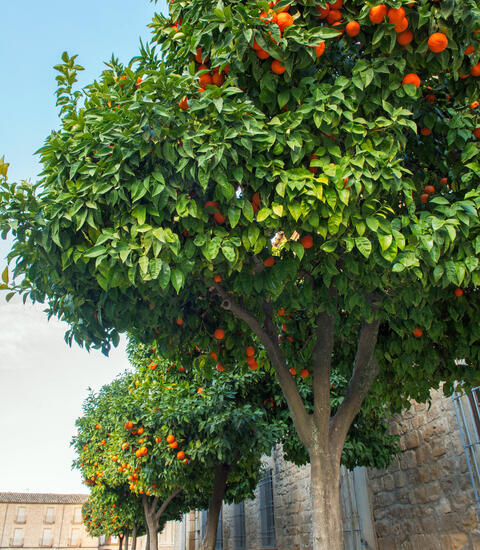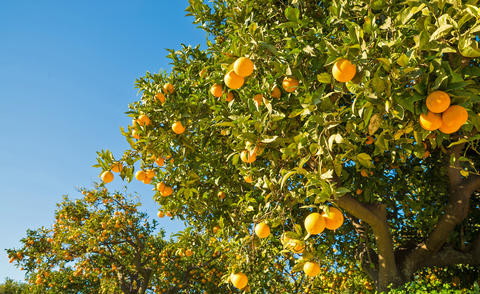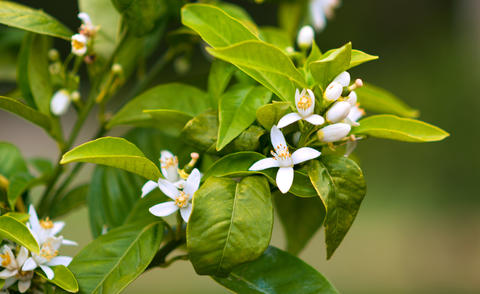Orange tree
Orange trees on the terrace are a real spectacle! But the fragrant exotics are not entirely undemanding in their care. You need to be aware of this when cultivating orange trees.
Factsheet
- Growth type
-
- small tree
- Growth height (from)
- from 700 cm to 1000 cm
- Growth characteristics
-
- spherical
- upright
- Flower color
-
- white
- Flowering time (month)
-
- February to June
- Flower shape
-
- 2 to 5 persons
- under the table
- in leaf axils
- Flower characteristics
-
- lightly fragrant
- Leaf color
-
- green
- page format
-
- oval
- Sheet properties
-
- evergreen
- Fruit color
-
- orange
- Fruit shape
-
- Berry
- Fruit characteristics
-
- edible
- Light
-
- sunny
- Soil type
-
- gravelly to loamy
- Soil Moisture
-
- fresh
- ph value
-
- weakly alkaline to neutral
- Lime compatibility
-
- lime-tolerant
- Nutrient requirements
-
- nutrient-rich
- Humus
-
- rich in humus
- Decorative or utility value
-
- Fruit ornaments
- Fruit
- Use
-
- Interior greening
- Planters
- Winter garden
- Garden style
-
- Mediterranean garden
- Orchard
- Bee Friendly
- bee friendly plant
Like the Lemon tree, the Orange tree (Citrus x sinensis) originates from the sub-tropical climate regions of China and is part of the large genus of citrus plants. This family belongs to the rue (Rutaceae) family. The Orange is not a naturally occurring fruit, rather a cross developed in China between the Tangerine (Citrus reticulata) and Grapefruit (Citrus maxima). The sweet fruit only reached the European continent centuries later, at the start of the 15th century, via the Portuguese breeding regions. Its immense popularity today makes the Orange one of the best-loved citrus fruits in the world. Incidentally: The color orange is named after the fruit - not the other way round. It is referred to in some languages as the ‘Chinese apple’.
Unlike the Lemon tree, the Orange tree grows relatively quickly with attractive branches and forms a round crown. Plantation trees grow up to 33 feet tall. Citrus x sinensis has long thorns on the young, angular branches.
The Orange tree leaves sit on stems and are arranged in a spiral around the branch. The Orange leaf is oval, slightly pointed at the end, dark green and has a leathery feel. The Orange tree foliage is evergreen and renews itself every two to three years.

The small, white flowers of the Orange tree appear in the spring, between February and June. They sit individually on the leaf axils and have a pleasant, orange fragrance. Due to the fruiting in late summer and the fall, Orange trees bear flowers and fruit at the same time. Bees love the fragrant nectar of Orange flowers.
Orange trees are self-fertile. This means they do not require a partner to form fruit. The roughly hand sized oranges which develop in late summer and the fall have a thick peel which is white on the inside and turns an orange color on the outside when maturing under a cold influence. In hot countries, the peel of some orange varieties remains green even after ripening. As European and North American consumers consider green fruit unripe, oranges harvested early in commercial cultivation in central Europe are de-greened with ethylene. The essential oil in the peel creates the typical Orange fragrance of the fruit.

Like all Citrus plants, the Orange tree likes a warm location in full sunlight, on a south or south-west terrace or a light balcony. It should also be protected from the rain and wind. As Citrus trees are somewhat ‘top heavy’ it should be positioned to prevent tipping. If you prefer to plant your Orange tree in a protected, sunny bed (for example, along a house wall), the trunk can be dug into the bed with the planter. This keeps the plant mobile and in the fall it can be easily moved to its winter residence. Due to its refreshing fragrance, the Orange tree is best placed near seating areas. The Orange tree can thrive in a pot even in a conservatory or a very light place in the house. However, care should then be taken to ensure as much light yield as possible and high humidity (for example, by spraying or showering).
Orange trees do well in a coarse, permeable, fresh-moist substrate which is firm and not slightly silty. There are special Citrus planting soils, however normal potting soil mixed with compost and coconut fibers or perlite also does the job. Too heavily dense, waterlogged substrate can lead to root rot. A drainage layer of expanding clay or gravel in the base of the pot ensures good water drainage.
As the Orange originates from sub-tropical regions in which high temperatures meet with heavy precipitation, this exotic plant generally requires a moist, warm climate. It is too dry for the tree at our latitudes, so care should be taken to ensure a good water supply. It should always be watered when the top layer of soil has dried out - but then it should be watered thoroughly. One clear indication that it’s watering time is when the leaves start to roll inwards. It should then be watered as quickly as possible. In hot summers this could mean daily. The assumption that Citrus plants require soft water has since been debunked in studies. Quite the opposite, Oranges need a lot of calcium, which is best supplied in hard, calciferous tap water. It must be possible for excess water to drain off, as waterlogging quickly leads to root rot in orange trees.

Orange trees should be given a Citrus fertilizer weekly during the growth period from the end of February to October. Green plant fertilizer is also suitable for Orange trees, as the citrus plant has a high nitrogen requirement but does not tolerate much phosphorous.
Orange trees are generally grown in containers. However, it does use up the substrate here really quickly, particularly in the first years, and the roots develop space problems. Therefore, Oranges should be re-potted annually. Older specimens can be placed in a new container when the crown has become larger than the pot diameter. This prevents the tree from becoming too wobbly. Tip: Select a pot for a Citrus tree which stands firmly and is rather heavier as the trees easily tip over outside in strong winds. They are re-potted in the early spring (February), when the Orange tree begins its growth period. For young plants which have out-rooted their old pot, choose a considerably larger container. For older trees, it is often sufficient to replace the substrate and return the tree to the old pot. Carefully knock the old soil from the root ball and place the tree, particularly if it is grafted, exactly as high as it stood in the old pot.
The naturally attractive Orange tree growth does not normally require shaping. Small corrections to ensure the crown remains beautiful and round and the removal of bothersome branches are appropriate measures. Dead leaves and branches should also be removed. The tree is normally pinched off regularly to retain its shape and contain its sizeable growth. Regularly capping the outer shoots also ensures beautiful, dense growth. Orange trees tolerate pruning and can be trimmed all year round. Plants are often cut back before moving in the fall, so that the Orange tree does not require too much space in its winter home.

Orange trees are not winter-hardy and at our latitudes, must be overwintered indoors, in cool conservatories or a frost-free greenhouse. At temperatures below 54 degrees Fahrenheit, the roots of the Orange tree enter a winter rest period and no longer draw water into the leaves. This means a winter home can be somewhere dark, for example in a garage with a window, provided it is appropriately cool, otherwise the tree will shrink due of lack of light. In a dark, winter home, the Orange tree will still drop the majority of its leaves.
The ideal spot for Orange trees to overwinter is in a frost-free greenhouse which allows sufficient direct light in, where the temperature does not fall below 41 degrees Fahrenheit (frost monitor!), but which also does not heat up too much during the day, particularly when the winter sun shines in. In a winter residence which is continually warmer than 54 degrees Fahrenheit, it must be as light as possible so that the plant can continue to photosynthesize. It requires considerably less water in a winter home, depending on how cool it is. If the orange tree is kept in a warm living room during the colder time of year (please with as much light as possible here, as well!), it will require the same amount of watering and fertilizing.
With Orange trees, there is a rough differentiation between the group varieties of Blond Oranges, Navel Oranges and Blood Oranges. Navel Oranges can be clearly recognized by their small ‘Navel’, which is actually an embedded second fruit. With large Orange fruits, dark green foliage and compact growth, these varieties are highly suitable for container cultivation. Blood Oranges have red colored fruit flesh due to anthocyanin deposits and taste a little more bitter than Light Oranges. ‘Sanguinella’ is an old and very popular variety for container culture. It bears lots of small, dark red fruit without seeds.
The variety ‘Tarocco’ serves up large, again, seedless fruit and a very high vitamin C content. The variety ‘Valencia’ is the most widely known of the blood oranges. It forms lots of small, juicy fruit very late (often not until May and is therefore also treated as a ‘juice orange’. A specialty are the ‘Sugar Oranges’ or ‘Vanilla Oranges’ which are very easy for sensitive people and children to eat due to their low acid content. Despite what the name suggests, the sugar content is not higher than in normal oranges.

Orange trees are generally available grafted in plant shops, whereby the plants become more compact, stable and resistant. However, existing Orange trees can also be propagated cuttings. For this, it is best to take head cuttings from the mother plant which are about half a year old and slightly woody, in the spring or fall. Take care to ensure that there are at least three to five visible, intact buds per branch. After cutting, remove the lower leaves, dip the cut end in rooting powder and place the shoot into a mixture of sand and potting soil, so that two buds remain under the soil. Tip: A handful of calcified Algae in the potting soil improves the growth rate. Then water the Orange cuttings and cover them with a transparent cover, (such as a film bag), as Orange trees require even humidity levels.
Citrus cuttings prefer a relatively high soil temperature of around 82 degrees Fahrenheit in order to take root. Places over radiators or a heated cultivation station are suitable. The first roots will show on the orange cuttings after four to six weeks. As soon as the first new leaflets start to show, the cover can be removed. If you want to sow Orange seeds, you’ll need to look around for mature fruit with kernels (the kernels have already been bred out in most supermarket fruit). Carefully remove the kernels from the fruit, rinse and dry them for 24 hours at room temperature. Then place the Orange kernels into a propagating substrate at a depth of around 3.94 inches. Note: Orange trees grown from kernels often take over 10 years before they first begin to flower. Until then, Orange tree teenagers grown from seeds will only show long thorns instead of flowers.
A typical symptom of sickness in Citrus plants is yellow coloring on the leaves (chlorosis). This indicates a lack of calcium or iron, it can be resolved with the appropriate fertilizer. However, you should first check the water supply to the Orange tree, as often incorrect watering is the cause of leaf discoloration and droppage. In a warm winter residence in particular, the Orange tree should be regularly sprayed with soft water and inspected for pest infestations. Mealy bugs, Scaly insects and love to spread on Orange trees in dry conditions. Root rot is a common Orange tree disease. In this case, dark spots appear on the lower area of the trunk which seep gum. The tree drops its leaves and the branches die, later the bark falls off. A tree which has fallen foul to root rot must be removed.

